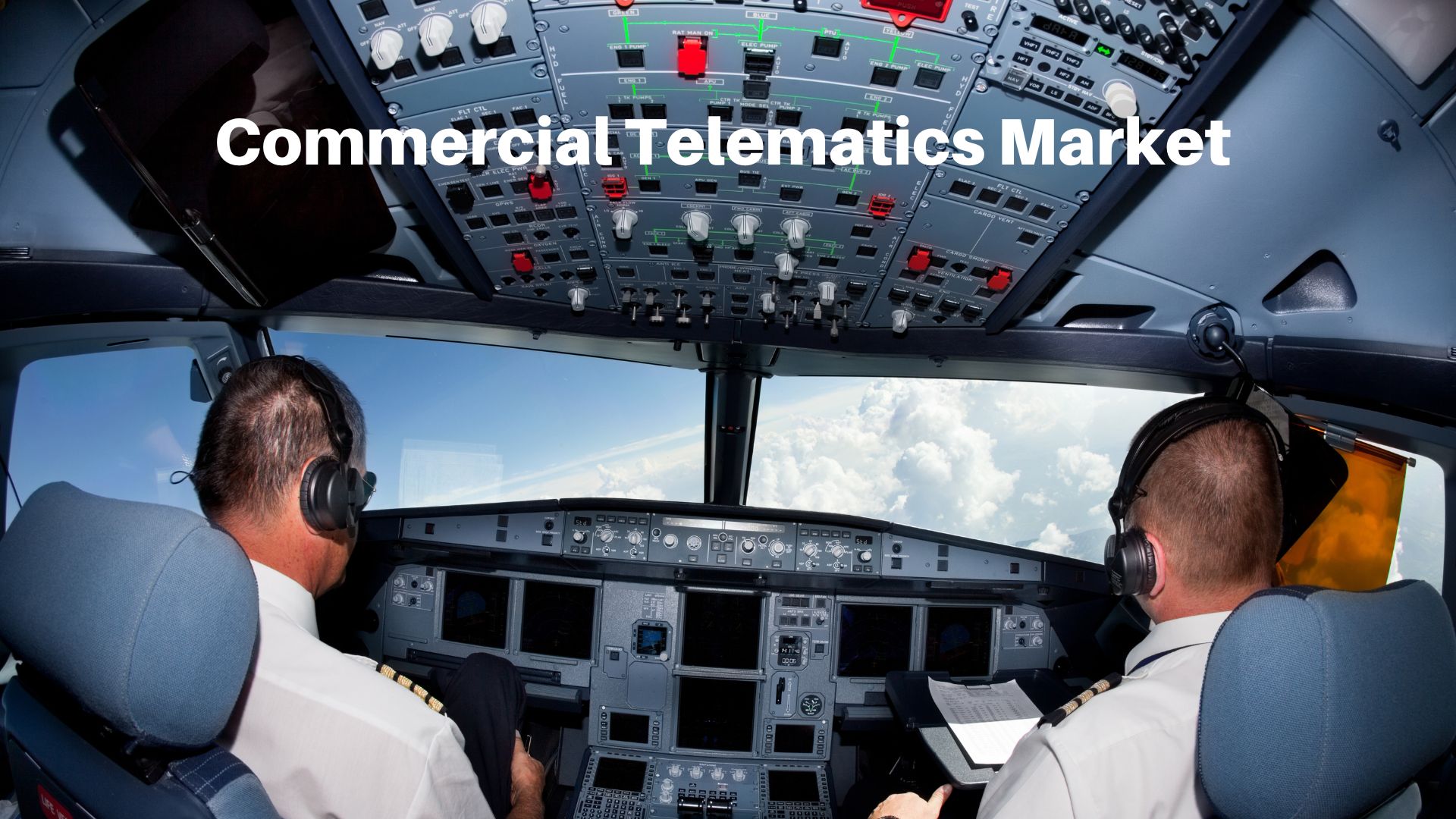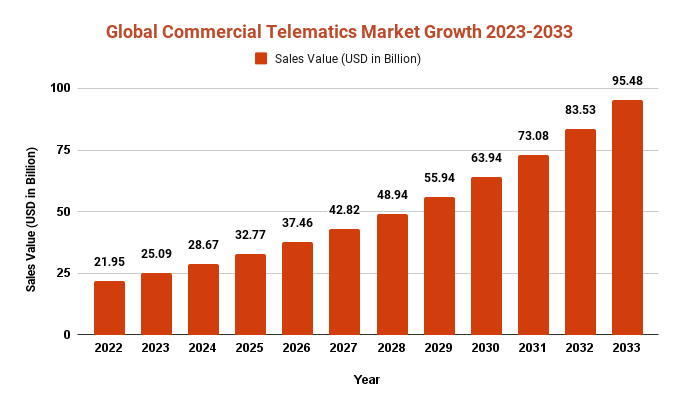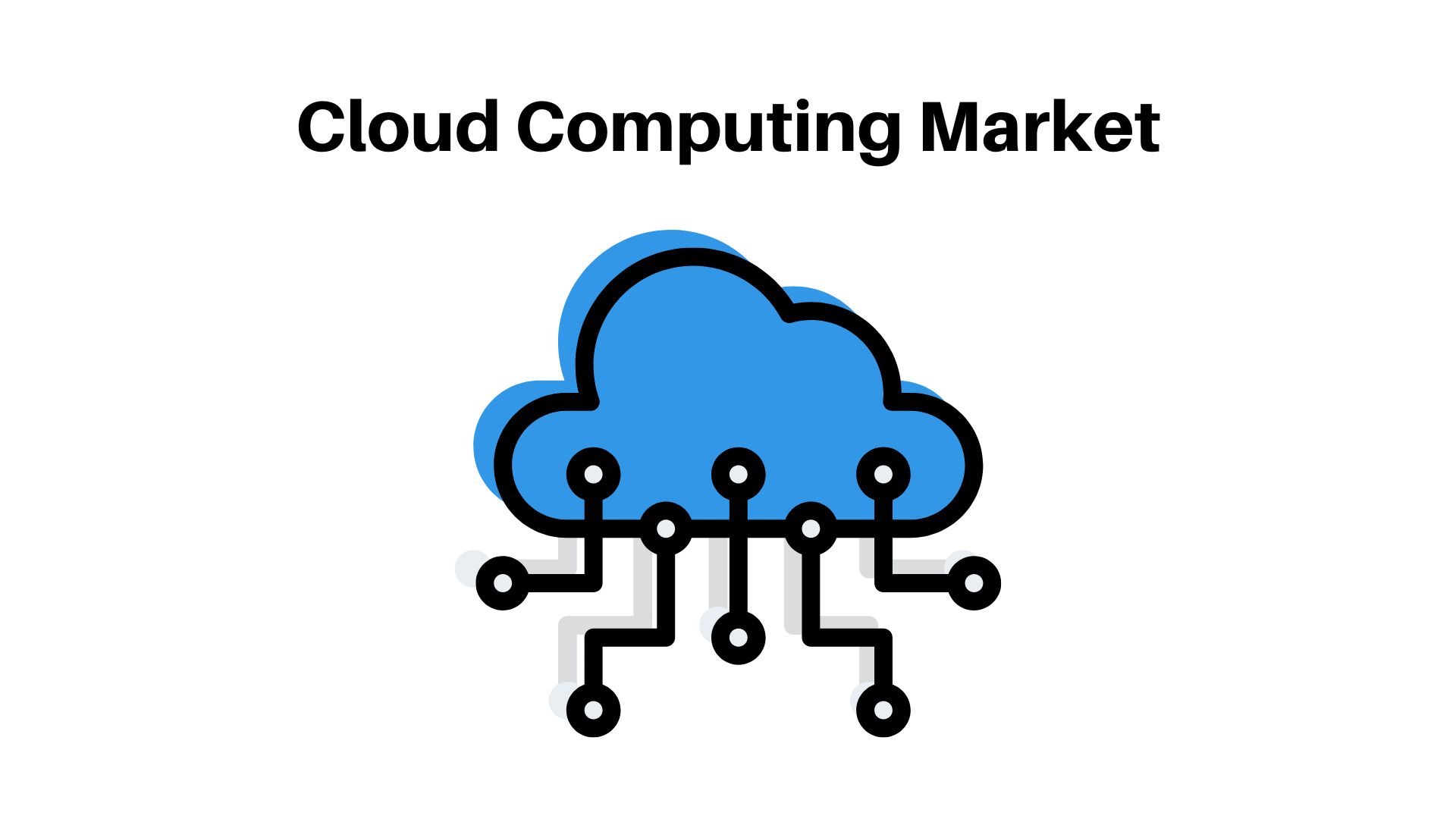Commercial Telematics Market Offers Key Insights To Boost Growth USD 95.48 Bn by 2033

Page Contents
Market Overview
Published Via 11Press: Commercial Telematics Market refers to the application of technology to monitor and manage fleets of commercial vehicles. It entails using devices like GPS trackers, sensors and communication tools such as communication tools that collect information such as location, speed, fuel consumption of individual vehicles or an entire fleet, then transmitting that data back to a central server/cloud-based platform where it will be processed, analyzed and utilized to make operational and strategic decisions. Commercial telematics has multiple applications for businesses, from fleet management and logistics to route planning, vehicle maintenance, driver safety and driver management. By optimizing operations using commercial telematics solutions, businesses are able to reduce costs, enhance efficiency and increase customer satisfaction – ultimately increasing business performance overall.
The Commercial Telematics Market size is expected to reach USD 95.48 Bn by 2033, up from its current value of USD 21.95 Bn in 2022, growing at an annual compound growth rate (CAGR) of 14.3% from 2023-2033.
Commercial telematics systems feature real-time vehicle tracking, automated vehicle maintenance alerts, driver behavior monitoring, fuel management and route optimization as key features that help companies more effectively manage their fleets while making data-driven decisions. These features give companies an advantage in fleet management while making data-driven decisions. Commercial telematics systems typically come as subscription-based offerings from vendors specializing in fleet management solutions. They can be tailored to fit the specific needs of individual companies while seamlessly integrating with existing enterprise software systems.
Key Takeaways
- Commercial telematics refers to the use of technology for tracking and managing fleets of commercial vehicles.
- GPS trackers, sensors and communication tools are used to collect data on the location, speed, fuel consumption and other metrics of individual vehicles or an entire fleet of vehicles.
- Data collected is then uploaded to a central server or cloud platform for processing and analysis in order to make operational and strategic decisions.
- Telematics for commercial vehicles offers many applications, from fleet management and logistics, route planning, vehicle maintenance and driver safety to driver performance analysis and driver monitoring.
- Key features of commercial telematics systems for businesses include real-time tracking of vehicles, automated vehicle maintenance alerts, driver behavior monitoring, fuel management, and route optimization.
- Commercial telematics systems typically come as subscription-based services from providers specializing in fleet management solutions.
- Commercial telematics assists companies to optimize their operations, lower costs, increase efficiency and ensure greater customer satisfaction.

Request Sample Copy of Commercial Telematics Market Report at: https://marketresearch.biz/report/commercial-telematics-market/request-sample/
Regional Snapshot
- North American commercial telematics market is the largest and most advanced in the world. The US represents its primary commercial telematics market due to a high demand for fleet management solutions within transportation and logistics industries.
- Europe is the second-largest market for commercial telematics. The United Kingdom, Germany and France are major markets in this region; demand driven by government regulations that seek to improve road safety while simultaneously decreasing emissions.
- The Asia-Pacific commercial telematics market is growing quickly, propelled by rising fleet management solutions demand in emerging economies such as China and India, supported by government initiatives aimed at improving road safety and decreasing traffic congestion.
- The Latin American commercial telematics market is relatively small but expanding quickly, driven mainly by rising logistics and transportation service demands in Brazil.
- The Middle East and Africa commercial telematics market is still in its infancy, with limited adoption of fleet management solutions. However, this market is expected to experience rapid expansion due to growing transportation and logistics demand across both regions.
Drivers
- Fleet Management Efficiency: Telematics solutions enable fleet managers to monitor and optimize operations more effectively while cutting costs and increasing efficiencies – key drivers for adoption as companies look for maximum return on investment for their fleet assets.
- Compliance: Governments around the world are increasingly adopting regulations aimed at improving road safety, lowering emissions, and increasing efficiency within the transportation industry. Commercial telematics solutions can assist companies in meeting these regulations while driving adoption within their market.
- An increase in logistics services: With e-commerce's rise and the demand for just-in-time delivery increasing rapidly, demand for logistics services has seen an exponential surge. Commercial telematics solutions help logistics firms manage their fleets more effectively while driving adoption in the market.
- Technological Advancements: Technological developments such as advanced analytics, artificial intelligence and machine learning have brought significant enhancements to commercial telematics solutions, prompting their widespread use across industries seeking ways to streamline operations. Companies increasingly leverage these technologies in their daily operations management strategies.
- Cost Reduction: Commercial telematics solutions can assist companies in cutting expenses by optimizing routes, improving fuel efficiency and lowering maintenance costs – key drivers for adoption in highly competitive markets where companies seek to maximize profitability.
Restraints
- High Initial Investment Costs: Implementation of commercial telematics solutions requires an initial financial investment that includes hardware and software costs as well as installation and integration expenses, which may prevent adoption by smaller and medium-sized enterprises (SMEs) with limited budgets.
- Data Privacy and Security Concerns: Telematics solutions may collect and transmit sensitive vehicle and driver location data that raises privacy and security issues, potentially hindering their adoption in industries where security is of critical concern. This may present as a barrier for adoption.
- Limited Cellular Network Coverage: Commercial telematics solutions often rely on cell networks for data transmission, which may present difficulties in areas with limited cellular network coverage and ultimately affect reliability and effectiveness of solutions in rural or remote locations.
- Integrating New Solutions: Many companies rely on legacy systems for operations management, making integration with commercial telematics solutions challenging and often impeding adoption; this can present additional hurdles in larger enterprises with complex IT environments.
- Lack of Skilled Personnel: Implementation and management of commercial telematics solutions require highly specialized skills and expertise that may be difficult for companies with limited IT resources to acquire. This could compromise the effectiveness of solutions implemented at smaller enterprises (SMEs).
Opportunities
- Expansion into New Markets: The commercial telematics market is experiencing rapid expansion in emerging economies such as China, India and Brazil, offering companies an opportunity to capitalize on this expansion by expanding into these new markets by using existing expertise and experience as leverage points for success.
- Development of new products and services: As the commercial telematics market continuously adapts to new technologies and customer requirements, companies should consider developing new products or services that address these varying demands, creating revenue streams for growth.
- Partnership and Collaboration: Partnering among players within the commercial telematics ecosystem can open up many doors of opportunity for innovation and expansion. Partnerships among telematics providers, fleet managers and vehicle manufacturers could result in new products and services tailored specifically to customer needs.
- Integrate with other technologies: Commercial telematics solutions can be integrated with other technologies, including artificial intelligence, machine learning and blockchain to develop innovative applications and solutions that provide new opportunities for differentiation and growth.
- Focus on Data Analytics: Commercial telematics solutions provide businesses with data that can help unlock insights and drive decision-making processes. Companies can take advantage of this by investing in analytics capabilities, developing services that utilize this data, and offering customers additional value through insights.
Challenges
- Data Privacy and Security: Commercial telematics solutions collect and transmit sensitive vehicle and driver locations that could raise privacy and security issues for companies. Companies should adhere to applicable data protection laws as well as implement robust safeguards against unauthorised access or misuse of such sensitive data.
- Limited Interoperability: Telematics solutions may use different data formats or communication protocols that make integration between solutions difficult, making data sharing across solutions harder than necessary and hindering development of services and solutions that require data from various sources. This can hinder innovation of new services and solutions that rely on multiple sources.
- Integration with Legacy Systems: Many companies rely on legacy systems to run their operations, making integration of new commercial telematics solutions difficult and often acting as a roadblock to adoption, especially among larger organizations with complex IT environments.
- Reliability and Accuracy: Telematics solutions utilise various sensors and communications technologies that may be susceptible to interference or failure, which could compromise the reliability and accuracy of collected data and reduce its impact on effectiveness of solutions.
- Cost: Implementation and maintenance of commercial telematics solutions can be expensive for smaller companies with tight budgets, so companies should make sure the benefits outweigh any associated expenses, providing a clear return on investment.
Market Segmentation
Type
- OEM Telematics
- Aftermarket Telematics
Application
- Insurance Telematics
- Fleet / Asset Management
- Satellite Navigation
- Infotainment
- Remote Alarm and Monitoring
- Telehealth Solutions
End User
- Healthcare
- Construction
- Transportation and Logistics
- Government and Utilities
- Insurance
Key Players
- AT&T
- Verizon Communications Inc.
- MiX Telematics Ltd.
- Trimble Navigation Limited
- TomTom
- OnStar LLC.
- BMW
- Verizon
- Telefonica
Report Scope
| Report Attribute | Details |
| Market size value in 2022 | USD 21.95 Bn |
| Revenue forecast by 2033 | USD 95.48 Bn |
| Growth Rate | CAGR Of 14.3% |
| Regions Covered | North America, Europe, Asia Pacific, Latin America, and Middle East & Africa, and Rest of the World |
| Historical Years | 2017-2022 |
| Base Year | 2022 |
| Estimated Year | 2023 |
| Short-Term Projection Year | 2028 |
| Long-Term Projected Year | 2033 |
Recent Developments
- Artificial Intelligence (AI) and Machine Learning: Commercial telematics solutions increasingly leverage AI and machine learning for data analysis, pattern recognition and insight generation – this allows companies to improve operations, cut costs and enhance customer experiences while remaining compliant.
- Focused attention on driver safety: Fleet operators prioritize driver safety as a top priority, and commercial telematics solutions increasingly feature features to boost it. Some solutions use cameras and sensors to track driver behavior and provide feedback on areas for improvement.
- Growth of Electric Vehicle Adoption: Electric vehicles (EVs) have seen tremendous adoption growth across Europe and Asia, driving demand for commercial telematics solutions that help fleet operators manage their EV fleet more effectively, such as information on battery life and charging station locations.
- Emergence of new business models: Telematics solutions are increasingly being offered as part of alternative business models such as usage-based insurance and pay-per-mile pricing, opening up new opportunities for providers of commercial telematics services and other players in the ecosystem.
- Expansion of Telematics Ecosystem: The commercial telematics ecosystem is expanding, with new players entering and existing players expanding their offerings. Vehicle manufacturers are increasingly including telematics solutions in their vehicles while technology companies create solutions utilizing data collected via telematics solutions.
Key Questions
- What Is Commercial Telematics?
Commercial telematics is the use of technology to oversee, optimize, and manage operations of commercial vehicles and fleets. This involves collecting and analyzing data on vehicle location, driver behavior, fuel consumption and other relevant metrics. - What are the drivers of the commercial telematics market?
Some key drivers include increased demand for efficient fleet management, rising adoption of connected vehicle and IoT technology and an emphasis on driver safety and compliance. - What are some of the challenges associated with commercial telematics market?
Some of the challenges facing the commercial telematics market include data privacy and security concerns, limited interoperability between various telematics solutions, integration with legacy systems, reliability/accuracy of data transmissions and cost. - What are some recent advancements in commercial telematics market?
Recent advancements in commercial telematics market include advances in AI and machine learning technologies, an emphasis on driver safety measures, increased adoption of electric vehicles, the creation of innovative business models, and expansion of telematics ecosystem. - What opportunities exist within the commercial telematics market?
Opportunities within this space include expanding into new markets, creating innovative products and services, developing partnerships or collaboration agreements, integrating with other technologies, and emphasizing data analytics.
Contact us
Contact Person: Mr. Lawrence John
Marketresearch.Biz (Powered By Prudour Pvt. Ltd.)
Tel: +1 (347) 796-4335
Send Email: [email protected]
The team behind market.us, marketresearch.biz, market.biz and more. Our purpose is to keep our customers ahead of the game with regard to the markets. They may fluctuate up or down, but we will help you to stay ahead of the curve in these market fluctuations. Our consistent growth and ability to deliver in-depth analyses and market insight has engaged genuine market players. They have faith in us to offer the data and information they require to make balanced and decisive marketing decisions.



